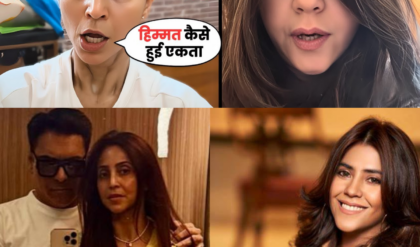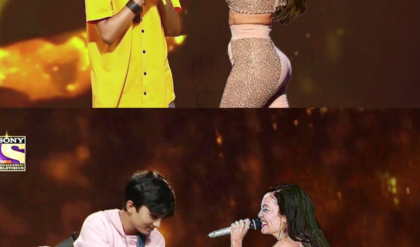The Complicated Dynamic Between Amitabh Bachchan and Deepika Padukone: Similarities and Conflict in Aarakshan
The world of Bollywood, where larger-than-life personalities often come together to create cinematic magic, is no stranger to complex relationships and conflicting dynamics. One such intriguing dynamic emerged between Amitabh Bachchan and Deepika Padukone, two of Bollywood’s most iconic actors, during the making of the film Aarakshan (2011). Directed by Prakash Jha, Aarakshan is a social drama that focuses on the sensitive issue of caste-based reservations in Indian education. Amidst the important themes explored in the movie, the film also brought together the legendary Amitabh Bachchan and the rising star, Deepika Padukone, who had her first collaboration with the megastar.
The relationship between Amitabh Bachchan and Deepika Padukone on and off the screen during the making of Aarakshan has been the subject of many discussions, particularly due to their contrasting experiences and the roles they played in the film. While both are powerful personalities in their own right, their characters in Aarakshan presented a sense of enmity that was palpable, both within the narrative and potentially in their real-life interactions.
Aarakshan: A Film that Explores Conflict
Aarakshan revolves around the contentious issue of caste-based reservations in India’s educational system. The movie features Amitabh Bachchan as Prabhakar Anand, a man who believes in merit-based education and struggles with the growing practice of reservation policies that provide affirmative action for the backward classes. On the other hand, Deepika Padukone plays Maitreyee, a student who becomes the face of the movement against these reservation policies. Her character represents the younger generation’s desire to break free from the old societal norms and fight for what she believes in.
The film, while addressing these pressing social issues, also delves into the tension between different perspectives on education, opportunity, and meritocracy. This tension is mirrored in the relationship between the two main characters played by Amitabh Bachchan and Deepika Padukone.
The On-Screen Conflict: Amitabh Bachchan vs. Deepika Padukone
The central conflict in Aarakshan is between Amitabh Bachchan’s character, Prabhakar Anand, and Deepika’s character, Maitreyee. While the movie primarily focuses on the larger issue of caste-based reservations, the tension between the two characters adds a personal layer to the narrative.
-
Contrasting Ideologies:
Amitabh Bachchan’s character is depicted as a staunch believer in merit-based education. As a principal at a prestigious institution, Prabhakar Anand is portrayed as someone who has spent his life fighting for the rights of those who excel based on their individual abilities and efforts. He embodies the old-school belief that opportunities should be earned and that affirmative action, such as reservations, dilutes the concept of merit.
Deepika Padukone, on the other hand, plays Maitreyee, a strong-willed and ambitious student who is deeply affected by the reservation system. Her character sees the reservation policy as a means of providing opportunity to those who are otherwise marginalized by the system. Maitreyee represents a newer generation’s progressive stance, viewing these policies as a tool for social justice and equality. The ideological difference between Prabhakar Anand and Maitreyee becomes the driving force of their conflict throughout the film.
The ideological clash between the two characters is, in many ways, a metaphor for the broader debate in Indian society. The struggle between tradition and modernity, meritocracy and social justice, sets the stage for an intense emotional and intellectual battle between the two characters.
The Clash of Generations:
Another significant aspect of the dynamic between Amitabh Bachchan and Deepika Padukone in Aarakshan is the generational divide. Prabhakar Anand represents the older generation — one that is grounded in its values, traditions, and a strong belief in merit as the defining factor of success. Maitreyee, in contrast, is a younger character who embodies the changing attitudes of youth, particularly those in the urban middle class, who believe in breaking barriers and challenging the status quo.
This clash of generations plays out not just in their ideological differences but also in their interactions with one another. Prabhakar’s character is initially dismissive of Maitreyee’s views, considering them naive and lacking depth. Maitreyee, on the other hand, sees Prabhakar’s traditional views as outdated and rigid. This dynamic highlights the tension between old and new perspectives, something that has been a recurring theme in Indian cinema, especially when dealing with social and political issues.
Parental Influence and Power Dynamics:
The relationship between the two also reflects the power dynamics between the elder and the younger characters, which is a common theme in Indian family structures. In Aarakshan, Prabhakar Anand’s authority as a teacher and mentor gives him a position of power over Maitreyee. His life experiences and career make him an authority figure, and Maitreyee’s rebellious nature in challenging him adds a layer of complexity to their relationship. However, as the narrative progresses, Maitreyee starts to challenge his authority, questioning his long-held beliefs and values.
While their relationship is based on ideological conflict, it also mirrors the generational tension that exists in real life, especially between parents and children who may hold different views on education, career choices, and societal values.
Real-Life Dynamics: Amitabh Bachchan and Deepika Padukone’s Professional Relationship
While their on-screen relationship was filled with conflict, the behind-the-scenes relationship between Amitabh Bachchan and Deepika Padukone during the filming of Aarakshan has been a subject of curiosity. Both actors have spoken highly of each other in various interviews, but their interactions have been less frequently documented compared to the level of media attention they often receive.
-
Mutual Respect and Admiration:
Despite the ideological differences of their characters, both Amitabh Bachchan and Deepika Padukone have expressed mutual respect for each other as professionals. Amitabh, known for his dedication to his craft, has often lauded Deepika for her commitment to her roles and her growing presence in the industry. He has been vocal in praising her acting skills and her ability to bring depth to her characters.
Deepika, in turn, has also expressed admiration for Amitabh Bachchan’s legacy and the vast experience he brings to any film set. She has often referred to him as a mentor figure in the industry, someone she looks up to for both his acting prowess and his humility. Their professional relationship has been marked by mutual respect, despite the intensity of their on-screen conflict.
Challenges of Working Together:
However, the working dynamic between the two actors may not have been without challenges. Amitabh Bachchan, with his decades of experience, and Deepika Padukone, who was still relatively new to the industry compared to him, might have found themselves dealing with different work ethics and approaches to filmmaking. Amitabh’s methodical and deeply philosophical approach to his roles contrasts with Deepika’s more modern, experimental style of acting. While this may not have been a significant problem on the set of Aarakshan, such differences often play a role in shaping the chemistry between actors on screen.
Personalities and Public Perception:
Another factor to consider is the contrasting personalities of the two actors. Amitabh Bachchan, known for his stoic and serious demeanor, has often been seen as a distant, authoritative figure, both in his films and in real life. Deepika Padukone, in contrast, has built her image around being approachable, warm, and deeply connected with her fans. This disparity in their personalities could have added another layer of complexity to their on-screen dynamic, which revolved around the theme of enmity.
Moreover, the media often plays a role in creating narratives around actors and their relationships. In the case of Amitabh Bachchan and Deepika Padukone, the media was quick to pick up on their on-screen conflict and may have exaggerated or emphasized the differences between them, creating a perception of tension even when the reality might have been less dramatic.
The Similarities: Common Grounds Between Amitabh Bachchan and Deepika Padukone
While the relationship between their characters in Aarakshan is rooted in conflict, there are also several similarities between the two actors that go beyond the surface.
-
Commitment to Social Issues:
Both Amitabh Bachchan and Deepika Padukone have been vocal about various social issues, and their characters in Aarakshan are aligned with their personal beliefs to an extent. Amitabh Bachchan, throughout his career, has played roles that highlight social issues, from Zanjeer to Shakti, and his work in Aarakshan continued this tradition. He has often used his platform to speak on behalf of the marginalized and underprivileged sections of society.
Deepika Padukone, too, has been an advocate for mental health awareness and women’s empowerment. Her character in Aarakshan reflects her real-life advocacy for equality and justice, and her willingness to take on roles that tackle hard-hitting social issues speaks to her commitment to using her fame for a greater cause.
Professionalism in the Industry:
Both actors are known for their professionalism. Amitabh Bachchan, despite being in the industry for over 50 years, continues to work tirelessly and takes each project with the seriousness it deserves. Deepika, who has been in the industry for over a decade, has also established herself as a professional who gives her best to every role she takes on.
Conclusion
The relationship between Amitabh Bachchan and Deepika Padukone in Aarakshan is layered and multifaceted. While their characters are enemies on-screen, their off-screen relationship is based on mutual respect and professionalism. Both actors have navigated the challenges of working together in a film that explored a complex social issue, bringing their unique perspectives and acting styles to the project. The similarities in their personal and professional lives, despite the contrasting ideologies in the film, create an interesting dynamic that transcends the boundaries of their on-screen conflict.
News
Scandalous! Celebrity Caught in a Shocking Incident with a Fan in Public!”
Shocking Incident Involving Kareena Kapoor: A Fan Misbehaves in Front of the Media In a deeply unsettling incident, Bollywood actress Kareena Kapoor Khan found herself at the center of an unexpected and distressing situation when a fan reportedly touched her…
End of content
No more pages to load






